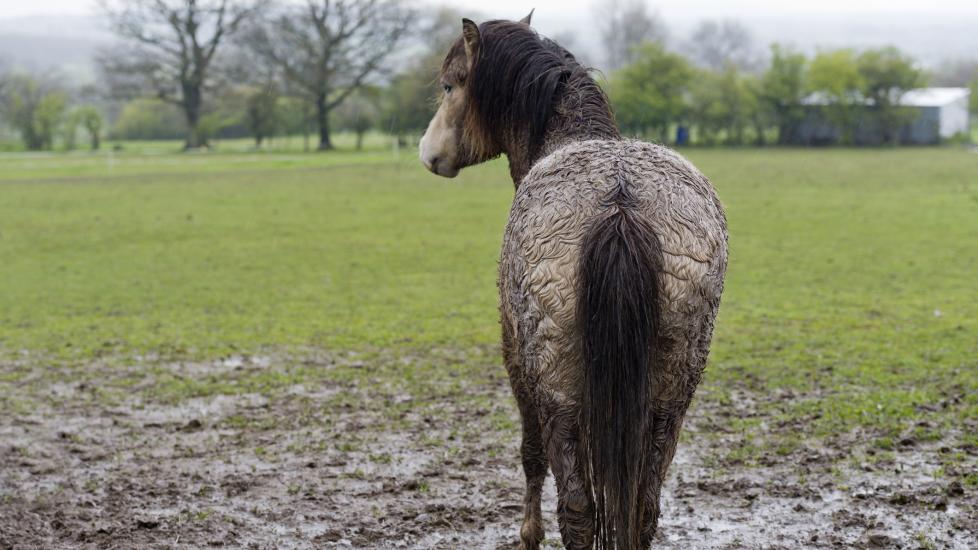Rain Rot in Horses
What Is Rain Rot in Horses?
Rain rot, also called dermatophilosis or rain scald, is a skin infection typically seen along the back and topline of horses or on the lower legs where moisture collects. Rain rot is most common in humid environments or in spring when rain is more frequent. It can affect horses of any breed or age.
Symptoms of Rain Rot in Horses
Common characteristics of rain rot include:
-
Patchy hair loss (typically along the back and topline or lower legs)
-
Crusts or bumps
-
Possible itchiness or discomfort, especially if these areas coincide with where tack sits
Causes of Rain Rot in Horses
The organism Dermatophilus congolensis is usually a harmless bacterium that lives on a horse’s skin. However, with prolonged exposure to moisture, the skin’s outermost layer can break down and become more easily damaged. This allows bacteria, fungi, and other organisms to get through the more fragile skin barriers and cause infection.
Horses that spend extended periods of time exposed to the elements or stand in a muddy or wet stall may be predisposed to developing rain rot.
How Veterinarians Diagnose Rain Rot in Horses
Diagnosis is typically presumed by the horse’s history and environment. Based on the location of lesions and crusts, and if your horse lives in a wet environment, your veterinarian may recommend treating for rain rot.
The only way to definitively diagnose dermatophilosis is via a skin scrape or biopsy to examine the affected cells under the microscope.
Treatment of Rain Rot in Horses
Treating rain rot in horses is relatively straightforward; if caught early, many cases resolve within a few weeks. However, if left untreated, rain rot can lead to:
-
Widespread infection of the skin
-
Severe pain or discomfort
-
Sloughing of the skin
-
Decreased appetite and lethargy
-
Systemic infection
If your veterinarian suspects rain rot, they may recommend using antimicrobial/antifungal shampoos or wipes. More serious cases that have wide-spread scabs, discharge, or discomfort may require more intensive treatment, such as antibiotics (penicillin is the most commonly used for dermatophilosis) to help with the infection or anti-inflammatories (phenylbutazone or flunixin meglumine) for discomfort. It’s important to keep the affected area clean and dry and keep your horse protected from rain or excessive humidity/moisture.
Rarely, in very severe cases or those that are difficult to treat, some horses end up humanely euthanized from rain rot due to a poor quality of life.
Recovery and Management of Rain Rot in Horses
There are several management practices you can try to prevent rain rot, including:
-
Allowing your horse a dry, padded stall or shelter away from the rain and mud
-
Frequently grooming and brushing your horse
-
Inspecting your horse’s skin daily
-
If a blanket or sheet is being used, take it off daily to check your horse’s skin, and clean the blanket regularly—while a blanket is a good barrier from cold and rain, it can also trap those things and act as an insulator, which can increase risk of infection
Rain Rot in Horses FAQs
What is the best home remedy for rain rot in horses?
Over-the-counter antimicrobial/antifungal shampoos are commonly used, such as KetoHex™.
Should you blanket a horse with rain rot?
If it’s cold and/or rainy out, a blanket may be an appropriate cover for your horse. However, it’s important to remove the blanket at least once daily to dry and groom the horse. Wipe off the blanket and ensure the horse is being treated with appropriate topicals/wipes if needed.
What happens if rain rot is left untreated?
If left untreated, dermatophilosis can continue to spread and become painful for the horse. In severe cases, systemic infection, cellulitis, and widespread painful skin lesions can develop.
What is the best thing to treat rain rot with?
Medicated shampoos, wipes, or topicals as advised by your veterinarian are the mainstay treatment, along with regular grooming and keeping the skin dry. In severe cases, your veterinarian may start antimicrobial therapy as well.
Does apple cider vinegar help rain rot in horses?
Using dilute apple cider vinegar topically for rain rot can be irritating to the tissues if used inappropriately or at the wrong concentration. Depending on the severity of your horse’s condition, your veterinarian may recommend over-the-counter options or prescribe topical or systemic medications.
Featured Image: dageldog/iStock via Getty Images Plus
